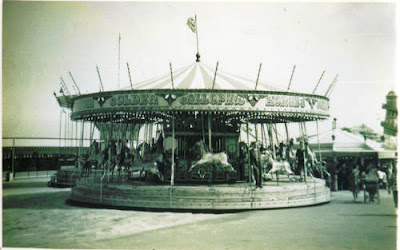Many people recognise the age of Pleasure Beach’s Scenic Railway Roller Coaster and assume it to be the oldest ride at the park. In fact that accolade is the Gallopers’, which was built in 1915. It has operated at Pleasure Beach each season since 1954, standing pride of place near the entrance.
 |
| Gallopers at Pleasure Beach in 1954 - its first year of operation at the park. Reproduced with permission of the University of Sheffield. |
The first carousels were relatively simply affairs called dobbies. These rides were roundabouts with fixed horses or other objects on which riders sat. Early examples were hand-cranked, or pulled around by pony, but steam engines soon took over and more elaborate designs emerged. The application of steam engines to roundabouts piqued the interest of Frederick Savage (1828 - 1897), who had become a successful agricultural engineer by developing existing technology, including the application of steam engines to machinery.
So, why Gallopers and not Carousel?
Savage set up a company at St. Nicholas Ironworks in Kings Lynn for the purpose of fairground ride production in 1873. His first ride was a steam-powered velocipede (a bicycle roundabout), soon followed by a ride called Land on Sea. This featured a set of ships in which riders sat. As the roundabout turned, eccentric wheels under the platform imparted an up-and-down rocking motion. Savage built roundabouts with horses using this principle - so-called platform gallopers, for the motion of the horses as the roundabout turned. In time, the design was improved by use of overhead cranks causing the horses motion, which provided a more compact setup than eccentric wheels under the platform.
So, why Gallopers and not Carousel?
Savage set up a company at St. Nicholas Ironworks in Kings Lynn for the purpose of fairground ride production in 1873. His first ride was a steam-powered velocipede (a bicycle roundabout), soon followed by a ride called Land on Sea. This featured a set of ships in which riders sat. As the roundabout turned, eccentric wheels under the platform imparted an up-and-down rocking motion. Savage built roundabouts with horses using this principle - so-called platform gallopers, for the motion of the horses as the roundabout turned. In time, the design was improved by use of overhead cranks causing the horses motion, which provided a more compact setup than eccentric wheels under the platform.
Savage established a reputation for excellent craftsmanship in this field and many of his rides were exported all over the world. Following his death in 1897, the business was continued by his sons until 1910, when the company became insolvent. The business was saved with assistance of the local MP, and productions of Gallopers continued until the mid 1920's where manufacturing focus shifted to aircraft and then marine engineering.
This ride at Pleasure Beach was built in 1915 for Charles Cain of Deptford, who supplied various attractions to fairgrounds of the time, and was originally called Colonial Galloping Horses. It consists of twelve rows of three horses and three chariots on a 47-foot (14 metres) diameter roundabout. Many of the horses are original, as carved by Savage's. The heads were made in three separate pieces from Siberian yellow pine with cast iron ears. Poplar and alder was used for the legs and the body, consisting of four separate pieces. The suspension rods were made from the waste ends of boiler tubes, a by-product of the steam engine manufacture. The original power unit for the ride was steam, but nowadays it is powered by electric. Likewise, the traditional fairground organ, operational for many years, has been replaced by an electronic sound system, although traditional fairground pipe music is still played.
 |
| The steam engine that powered the Gallopers. Reproduced with permission of the University of Sheffield. |
Botton Brothers secured the deal as amusement caterers to Bertram Mills' International Circus, which performed at London’s Olympia each Christmas from 1953 until 1967. It’s not clear when Botton Brothers acquired Gallopers, but they took it to Olympia for the 1953 show, where Queen Elizabeth II rode it. It was then transported to Great Yarmouth and installed pride of place near the entrance to Pleasure Beach for the 1954 season. The ride featured in the Olympia line up in subsequent years, but has entertained visitors of all ages at Pleasure Beach each season since.
 |
| Gallopers at Olympia in 1963. Reproduced with permission of the University of Sheffield. |
 |
| Gallopers standing pride of place near the entrance to the park. |
 |
| Many of the horses are original, hand carved at Savages' in Kings Lynn. |
Each winter, the ride is dismantled, serviced, cleaned and repainted where necessary, before being reassembled the following year. Long may it entertain visitors to Pleasure Beach.


No comments:
Post a Comment